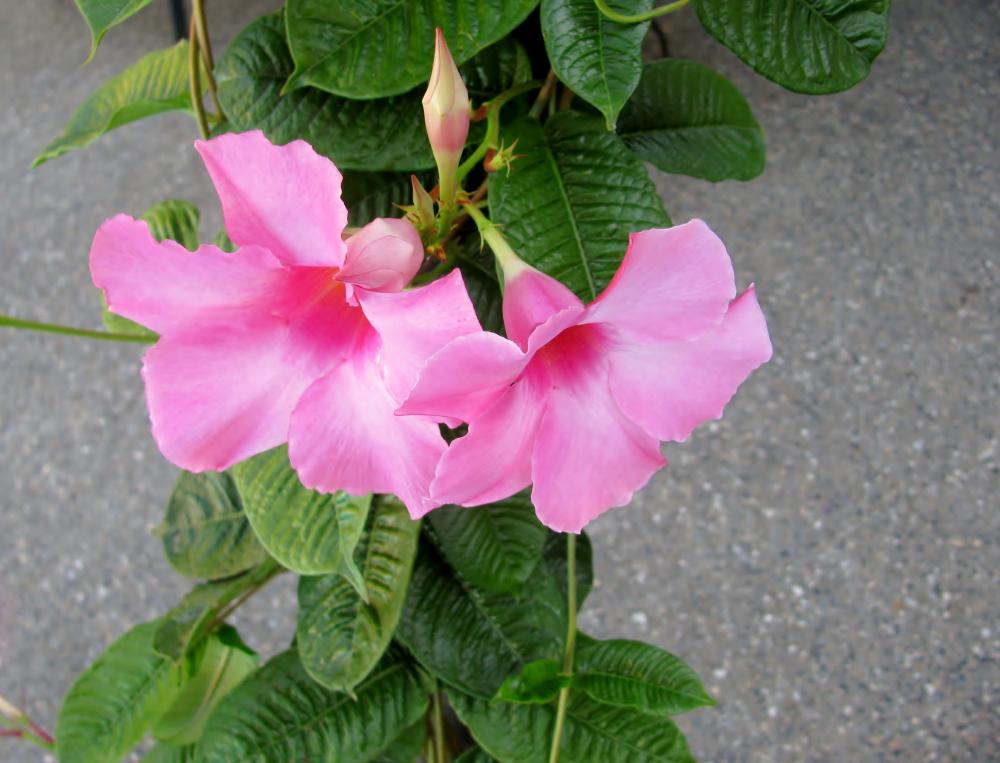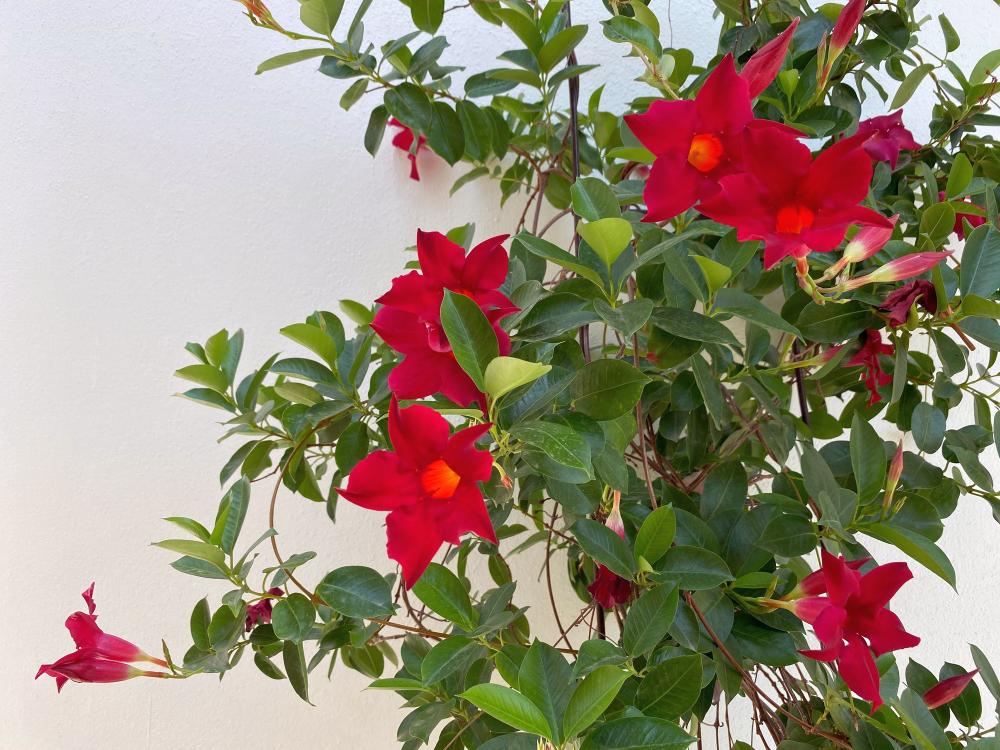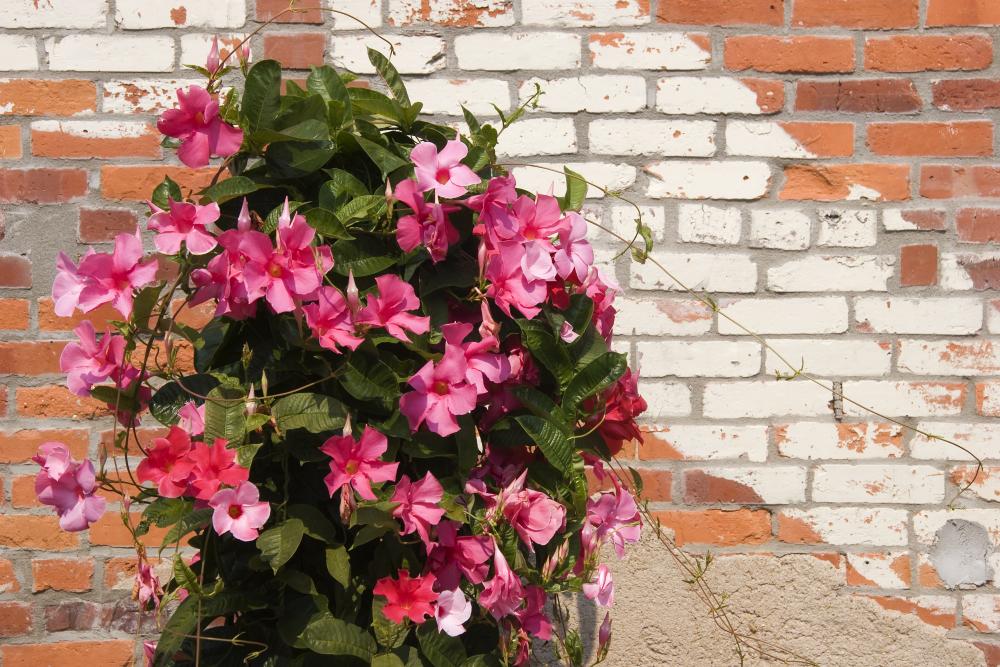Mandevilla Trellis Vine: Growing & Caring for the Rocktrumpet Plant
The Mandevilla (rocktrumpet) is a cocktail of elegance, bliss, and longevity. This flowering masterpiece found its way into the gardening scene through true resilience, whether growing inside a hanging basket or outdoors. Apart from looking stunning in a landscape setting during the summer or spring season, the tropical vine gets trails vigorously, so long as the conditions are suitable.
We took time to check out the basics which you want to work with when growing and caring for the Mandevilla trellis vine. Keep reading to find more about the steps you need to take in order to make this trailing vine look exotic throughout the seasons.
Mandevilla Trellis Vine at a Glance
The Mandevilla vine is a prepossessing, tropical plant that blooms generously. The flowering houseplant is a member of the Apocynaceae and is also commonly dubbed the ‘rocktrumpet’ in most nurseries. It grows in quite an exuberant manner under tropical and subtropical climates. It’s easy to care for most Mandevilla plants if you can try to keep up with their tailored growing conditions. While the plant can survive outdoors in the garden, it still looks elegant inside a hanging basket.
If you want the Mandevilla vine to practice its trailing habits, then you need to grow it near a structure that the plant can climb on. The showy blooms will appear during summer and some parts of the spring season. It’s worth noting that the plant generally sprouts without issues by tweaking the humidity, light, and temperature levels to suit its needs. Most newbie growers tend to confuse the Mandeville with its close cousin, the Dipladenia bush. So, be sure to check the label when purchasing to be certain.
Popular Mandevilla Varieties
Mandevilla laxa: The type is commonly dubbed Chilean jasmine in most nurseries and gardening stores. It features some white blooms that are intensely scented and can reach up to 20 feet tall when grown under optimal conditions. Each stem can hold up to 15 flowers during the blooming season. The flowers usually have 5 large lobes and yellow traces in the middle.
Mandevilla boliviensis: What’s eccentric about this type is its woody stems that can elongate up to 10’ inches long. Same as the Chilean jasmine, the white flowers for the boliviensis have a yellow throat, and tend to bloom during summer. It’s also often referred to as the white Mandevilla. On average, it can achieve a height of between 3 and 10 feet tall. If you want the plant to look shorter, you’ll need to prune it back during the spring season.
Variegated Mandevilla: Grow this type if you’re looking to own a houseplant with an exotic color. You’ll find lots of Mandevillas with variegated foliage in nurseries and gardening stores. While the leaves have a tender texture and are held by soft stems, variegated Mandevilla varieties such as the ‘Ice Fury’ or ‘Tropical Dreams’ are unfussy plants and need little maintenance throughout the seasons.
Summervillea Mandevilla: The Summervillea Mandevilla is a hardy variety with lush foliage and red flowers. It grows profusely when treated as a perennial in areas like Miami and Florida. For the most part, it likes to grow under a bright spot, but won’t tolerate frost, so you’ll need to move it indoors during winter.
How to Grow the Mandevilla Trellis Vine
To grow the Mandevilla vine, you need to mimic the tropical conditions to which the plant has been accustomed right from its indigenous place. Keep the medium far from frost conditions and keep try to keep night temperatures above 50 degrees Fahrenheit if your Trellis vine is growing indoors. One way to reproduce this houseplant is through stem cuttings. We’ll look at all other options you can use to propagate the plant later in this guide.
If you’re looking to grow it outdoors, this Mandevilla type will sprout beyond all expectations under USDA hardiness zones 9-11. For growers living on the northern part of the zones (most part of the U.S.), the plant will survive and bloom in the region, but you’ll need to move it indoors during winter. These tips will be handy when growing the Trellis vine:
- Pick a spot that gets lots of bright, indirect light. The tropical vine needs some partial shade during afternoon hours.
- Protect the foliage from intense heat primarily if you live in a region where summer months are relentlessly hot. But overall, aim for 6 to 8 hours of sunlight every day.
- Next, prepare the potting soil by picking out the top layer of normal soil, then mixing it with a portion of organic compost manure. Amend the mixture with perlite or sand to improve drainage.
- Dig holes about 5 inches deep, then plant the stem cuttings. You can add manure at the bottom of the hole before planting to increase the nutrient composition during the sprouting phase.
- Keep the soil moist to provide optimal growing conditions and give the cuttings the right amount of humidity they need.
Mandevilla Plant Caring Guide
Flowering & Fragrance
One thrilling fact about the Mandevilla vine is it’s a cheerful bloomer. Every summer, the vine will produce some eye-pleasing flowers. However, blooming depends on a few growing conditions. In order to produce more buds, the plant will need to grow in a bright location. Move the medium to a spot that can have access to between 6 and 8 hours of sunlight each day. Using fertilizer can also help speed up the blooming process.
Light Requirements
To grow this plant and make it gleam throughout the season, you need to strike a balance between light and shade. Keep the growing medium somewhere the plant can get the right amount of bright, indirect light for optimal chlorophyll production. Access to light also helps heighten the chances to produce more colorful flowers. Growing your Trellis vine under the full sun is fine, but a little bit of shade would protect the foliage from getting scorched.
Again, during sunny days, it should get at least 6 hours of bright light. It’s inversely worth noting that too much shade will lead to stunted growth and inhibit the plant from producing flowers. Place the medium in a position where the plant won’t suffer from leggy growth while desperately trying to search for light. Protect the plant from the afternoon sun since it’s usually a bit more intense and can burn the leaves.
Temperature
This trailing vine prefers to grow in a warm environment. Aim for a location with temperatures ranging from 60 to 80 degrees Fahrenheit. If the outdoor temperatures constantly start to fall below 50 degrees Fahrenheit, you’ll need to move the growing medium inside. And that’s more reason why most gardeners will grow plants of this kind inside containers.Overnight cold temperatures cause dreadful effects to the Trellis vine. You can bring the plant outdoors once the frost period is over. During the blooming period, the plant will need a warm surrounding quite constantly. On the other hand, you also need to get glued to the fact this houseplant isn’t frost-hardy.
Soil & Transplanting
All the Mandevilla plant needs primarily when it comes to the soil requirements is a medium that can drain excess moisture without any lags. To do that, you will need to use a portion of sand, besides the normal potting soil, then make amendments using organic material. Another way to improve drainage is by placing coarse gravel on the bottom part of the container.While drainage is of utmost importance, the soil still needs to retain some bits of moisture. The suitable soil pH that could accommodate this plant way better is one that’s slightly acidic to neutral. It can also keep up with slightly alkaline soil.
Loosen up the soil before planting the Trellis vine. Apart from sand, amending the potting mix with equal portions of peat moss or coco coir would help keep the soil aerated. Use a container with enough drainage holes that will release any extra moisture in the soil. Don’t pick an oversize container as this trailing houseplant prefers to grow in a somewhat compact setup. However, it needs to have room for the development of the root structure. If the roots are squeezed together and have no room for growth, the plant will look stunted, fail to absorb essential nutrients, and might not produce any flowers.
When it’s time for transplanting your Mandevilla vine, this would be the perfect opportunity to prune the plant, get rid of any dead leaves, and inspect the roots for any signs of rotting. The best time for transplanting this flowering houseplant is during spring when the growth hormones have already bounced back from their dormancy. Be careful not to cause any damage to the roots when uprooting and repotting the plant. You can transplant your Mandevilla vine annually or once every two years.
Watering
The watering intervals will depend on how permeable the soil is to support quicker drainage. One distinct feature about the Mandevilla vine is it doesn’t need to grow around high moisture levels at all times. It can glow and produce flowers, even when the watering intervals are intensely spaced out. Therefore, you will need to moisten the soil only when necessary. However, the catch is it will need a lot of consistency regarding the moisture levels. Be sure to keep the soil moist during the growing seasons, but don’t leave it too soggy. Any intense moisture getting stuck in the soil might lead to root rot, alongside a bunch of other hard-to-treat fungal infections.
It’s perhaps more reason why most pro-gardeners insist on growing this plant inside a container with enough drainage holes. If you’re living in an arid climate, you will need to constantly regularize the moisture levels to protect the foliage from drying up. You can use a cool-mist humidifier if the humidity levels tend to keep on falling below 50%. The remedy would work perfectly if the plant is growing indoors. If you notice any signs of distress on the foliage, it could mean that you need to increase the number of times you water the plant.
Feeding
If you’re looking to buy your Mandevilla vine from a nursery or gardening store, there are chances it will have already been fed with a slow-release fertilizer. Its potency could last for a few months, so there won’t be a need for feeding the plant. Adding more fertilizer will end up burning the roots. When using a slow-release option to feed this vine, make sure to dilute it at half its strength. Apart from mulching which helps a lot with moisture retention, top dressing the soil with organic material would be an effective way to replace essential nutrients that are absent. The needs of a Mandevilla growing outdoors might differ from those of one planted in the garden.
While the fertilizer needs to be well balanced, feeding this plant with a higher dose of phosphorus would help give it enough energy for chlorophyll production.It also promotes new growth, especially after the plant has experienced wilting or is at the early sprouting phase. For this reason, you want to go for a fertilizer whose composition is in the ratio of 10-20-10. The best time to feed your Mandevilla plant is during spring or summer when the conditions for blooming and developing more growth are favorable.
Grooming & Maintenance
To maintain its graceful appearance, it’s best to prune the Mandevilla vine at least once every year. Get rid of any leaves that have noticeable signs of wilting. For new growth, winter or the early weeks of spring are the best times to cut the plant back. Pruning this plant when it’s late will reduce the chances of blooming since you might end up removing the buds in the process. Don’t trim the plant to more than one-third its initial size. Always check the overall structure of the soil to see if it still has the capacity to enhance drainage.
Tips on Overwintering the Trellis Vine
Overwintering would be a worthy exercise to do since this plant can’t tolerate frost conditions. You’ll need to bring the growing medium inside once the outdoor temperatures fall below 50 degrees Fahrenheit. Before moving it indoors, make sure to thoroughly inspect it for any signs of pest infestations. Pests like to hide on the underside of the leaves, flowers, and stems. To keep it away from cold drafts, treating the vine as a houseplant during winter would be a necessary step to take.
The ideal indoor temperature needs to fall anywhere between 60-80 degrees Fahrenheit, so you want to tweak the levels if you’re looking to keep the plant alive during winter. Around this season, it’s normal for the Trellis vine to grow at a sluggish pace since the growth hormones tend to enter into a dormant phase. The other step is to trim the plant quite often and keep the medium close to the sunniest spot. Don’t expect it to bloom during this time. Keep the soil lightly moist and reduce the watering intervals since drainage would take much longer during winter.
Overwatering this plant during winter is a dreadful step that could ruin the roots and cause them to die off eventually. If you don’t have any designated or a sunny location to keep the medium, you can choose to force it into dormancy. To do so, carefully uproot the whole plant from the ground. Moisten the soil before uprooting to reduce friction that could damage the roots. Dust it off and use water to remove any soil clamped on the roots. At the same time, you want to store it while the roots are tucked inside the soil. You also want to check if the plant has any pests on it. Cut the plant back to roughly a third of its initial size.
Place it in a dry location like your garage over winter to increase the chance of becoming dormant. Keeping it away from the sun usually helps make the vine dormant a lot faster. You can choose to cover your Mandevilla plant with a plastic back, but some growers leave it uncovered. Regularly check if the soil on the roots has dried up, and add some water just to keep the Trellis vine alive.
How to Propagate the Trellis Vine
It’s easy to propagate the Trellis vine using stem cuttings. Or you can just opt to purchase a couple more of them from a nursery. The other option would be to collect seeds from the mother plant. However, this might be a little tedious, could take much longer before showing tangible results, and the offspring won’t always resemble the mother plant.
Propagating Using Seeds
The best time for sowing seeds is during the spring season. It should be done indoors. To propagate the Mandevilla vine using this method, it’s best to use an organic seed starting mix if you want them to take less time during the sprouting stage. Lightly cover the seeds, moisten the starting mix, then place the seed tray in a warm location. The seeds also need access to sunlight, but you can choose to use grow lights. Keep the temperature at a constant range of about 70 degrees Fahrenheit. If not, the seed coat will take longer to crack open.
Propagating Using Cuttings
You can leverage the time for pruning—preferably weeks before winter checks in—and take some cuttings from the mother plant. To prepare a stem cutting for rooting, you will need to get rid of the lower leaves, but leave about two sets on it. Each cutting needs to be around 3’-5’ inches long and have a few nodes. Apply some rooting powder if you want to speed up the formation of roots. The next stage would be to prepare the potting soil. Use some of our tips right under the ‘soil and transplanting’ section to make the soil structure, then chop the base part before planting it in the soil. Press the soil around the cutting downwards to make it firm.
Place the growing medium somewhere with enough bright, indirect light. You can choose to wrap the pot using a plastic bag that will protect the cuttings from extreme conditions. Make sure to open the plastic cover regularly to avoid breeding mold or other fungal diseases. It’s important to provide ventilation during the entire rooting period. Keep the soil lightly moist and check if the soil is draining excess moisture as it generally should. Usually, cuttings will take less than a month to form roots.
Mandevilla Vine Care: Common Pests & Diseases
Most Mandevilla types don’t struggle with serious problems or pest infestations. Even so, there are instances when the plant gets infested by pests like aphids, spider mites, scale insects, and whiteflies. Aphids, for example, like to prey on plants that are grossly neglected. Leaf damage or discoloration are some of the signs that your Trellis vine is infested by pests.
Before moving the growing medium indoors during winter, you want to thoroughly check whether it’s hosting some of these pests. That would be a solid measure that helps effectively curb the spreading of pests to other potted indoor plants. To suppress mass infestations, you can opt to replace the potting soil or flush harmful living organisms using water. Neem oil or an organic insecticidal soap are both potent remedies that can help get rid of pests like aphids, thrips, and whiteflies.



